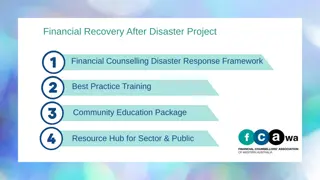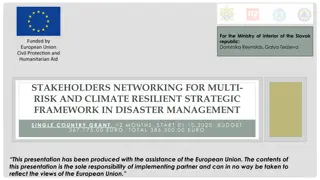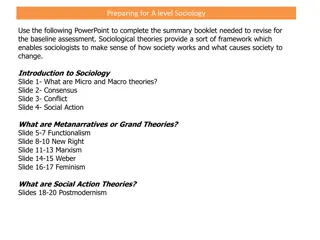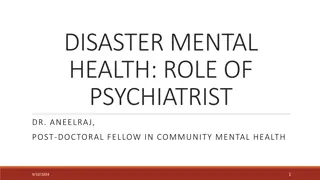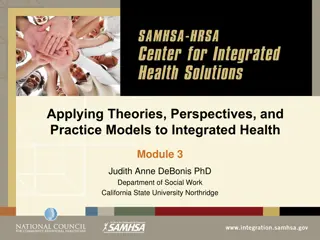Understanding Theories and Models of Disaster
Works on disaster traditionally focus on natural triggers and human responses, but older views are considered incomplete. The Pressure-Release Model (PAR) explains vulnerability and risk reduction, highlighting underlying causes and unsafe conditions. Root causes such as economic, demographic, and political processes contribute to vulnerability and need addressing to reduce disaster risk.
Download Presentation

Please find below an Image/Link to download the presentation.
The content on the website is provided AS IS for your information and personal use only. It may not be sold, licensed, or shared on other websites without obtaining consent from the author. Download presentation by click this link. If you encounter any issues during the download, it is possible that the publisher has removed the file from their server.
E N D
Presentation Transcript
Theories and Models of Disaster 3.1. Conventional Views Most works on disaster emphasizes on the trigger role of geo-tectonics, climate or biological factors arising in nature. Others focus on the human response, psychological, and physical trauma/shock, economic, legal and political consequences. Both of these sets of literature assume that disasters are departures from normal social functioning. The views that have existed before the emergence of models of disaster were not comprehensive enough to deal with all factors involved in explaining risk and hence can be considered as incomplete.
3.2. The Pressure-Release Model First published in 1994 by Blaikie et al. (1994) and again by Wisner et al, 2004, the disaster pressure-Release Model (PAR) has become the internationally accepted model for the explanation of the progression of vulnerability and the progression to safety (risk reduction). PAR is one of the two disaster models advanced by Blakie et al. (1994) aimed at showing how vulnerable people are affected by natural hazards. The model consists of two main components. One is vulnerability on human or social side and the other is a natural event which is termed as hazard . The basis for the PAR idea is that a disaster is the intersection of two opposing forces: those processes generating vulnerability on one side, and physical exposure to a hazard on the other. The released idea is incorporated to conceptualize the reduction of disaster.
The Pressure model indicates that there are certain underlying causes, dynamic pressures and unsafe conditions which contribute to vulnerability. In order to reduce the risk of communities as the pressure model one need to engage in certain risk reduction activities. The model presents a number of human and natural factors in the cause and effect chain whereby the variables to be involved alter according to the type of disaster under question. The original pressure component of PAR is simplified in the figure below. A clarification of every variable in the chain is very important in order to have a better understanding of the model. The social related components of the disaster are represented by vulnerability which is in turn produced by interaction between three factors: root causes, dynamic pressure and the resultant unsafe conditions . Regarding their relationship, dynamic pressures channel root causes into unsafe conditions that become subjected to faster rate of change.
Figure 2: Chain of human and natural hazards that result in disaster or risk/Vulnerability
Root causes: the root causes that give rise to vulnerability, as well as reproducing it over time, are economic, demographic and political processes, which by and large affect the allocation and distribution of resources between different groups of people. Such root causes are normally a function of the economic structure, of legal definitions of rights, of gender relations and other elements of ideological order (Blakie et al, 1994). In the context of rural Ethiopia, multiple attributes are identified as the underlying causes of food insecurity: lack or unequal access to land, lack of farm oxen and livestock at large, non-participatory policies, poor rural infrastructure, poor marketing, lack of access to rural credit, illiteracy and unskilled labor and gender inequality. Distribution of power in the society is another very important aspect of vulnerability. In this connection Blakie et al (1994) argue that those who are economically marginalized, and those who live in marginal environments can become vulnerable to food shortage.
Dynamic Pressures: these are processes and activities that translate the effects of root causes into vulnerability of unsafe conditions. These include reduced access to resources as a result of the way regional or global pressures such as rapid population growth, epidemic diseases, rapid urbanization, war, foreign debt and structural adjustment, export promotion, mining, hydropower development and deforestation work through to localities. Rural urban migration is also cited as an important dynamic pressure on root causes. Its main consequences are through erosion of local knowledge and institutions which are vital in disaster mitigation, as well as in terms of productive labor loss in rural communities. In the Ethiopian context, the major pressures on people s livelihood emanates from rapid population growth, frequent change in rural policies, over utilization of resources (soil and vegetation), static technology and crop and livestock yield decline.
Unsafe Conditions: according to Blakie et al (1994) unsafe conditions means the specific forms in which the vulnerability of a population is expressed in time and space in conjunction with hazard. Put differently, unsafe conditions refer to living in insecure situations and when people have limited capacity to withstand any kind of hazard. Some of the examples of unsafe conditions are living in dangerous locations, unable to afford safe building, lack of effective protection by the state, working in dangerous and failure in food entitlements. Among some of the unsafe conditions that highly threatened the food security of the people in rural Ethiopia are degraded environment, entitlement failure, inadequate harvest, low purchasing power, poverty, landlessness, and human and livestock diseases.
Limitations in the PAR Model Like any other famine models, the PAR model has certain limitations that should be recognized before applying it as a research framework. The principal drawbacks of the model that were admitted by the pioneers themselves include: It suggests that the hazard event is isolated and distinct from the conditions that create vulnerability. It does not take into account the fact that hazards themselves alter the set of resources available to households and alter the pattern of recoverability of different groups of people. The case of drought would well demonstrate the issue because it can considerably erode a resource endowment of households, making some of them poor and others destitute, in fact depending on their degree of sensitivity and resilience in pre-crisis period.
In analyzing the linkages between root causes, dynamic pressure and unsafe conditions, it is rather exceptional to have reliable evidence, especially farther back in the chain of explanation we go. The model assumes that cause and effect relations can be easily established among the three main components of the model. Apart from these drawbacks, the model can be criticized on two grounds. First, it gives little attention to the cultural aspects of the people. Social networks, traditions are not encompassed by the model. Secondly, it highly simplified the complex and diverse realities of a society. values and
Wisner et al. (2004) identified seven risk reduction objectives which follow logically on the PAR model. These include: C = Communicate understanding of vulnerability A = Analyze vulnerability R = Focus on reverse D = Emphasize sustainable development I = Improve livelihood A = Add recovery C = Extent to Culture
3.3. The Access Model The access model has been put forward as an alternative to the PAR model. The model aims at addressing two important issues. First, it is meant to capture/confine some of the caveats/cautions observed in relation to PAR model. Second, it regards nature to function within the framework of the social processes. The access model focuses on the way unsafe conditions arise in relation to the economic and political processes that allocate assets, income, and other resources in a society. Nature itself (land, water, vegetation, etc.) constitutes a part of the resources that are allocated by social processes, and under these conditions people become vulnerable to hazard impact. Hence, the model attempts to combine the political economy approach with other factors that explain societal functioning.
This is because there is a belief that vulnerability variation between households to various hazards is mainly due to class differences created by existing socioeconomic systems. In other words, access to resources is determined households in terms of class structure in a society: Households with better access to information, cash, rights to the means of production, tools and equipments and the social networks to mobilize resources from outside the household, are less vulnerable to hazards, and may be in a position to avoid disaster. Their losses are frequently greater in absolute terms but less in the relative terms, and they are generally able to recover more quickly. by the position of
It is apparent that the wealth status and the power to be exercised by households or individual members are the crucial factors in terms of indicating the level of vulnerability to natural hazards. Cognizant of this reality, Blakie et al. (1994) describe access as the ability of an individual, family, group, class or community to use resources, which are directly required to secure a livelihood. Access to those resources is always based on social and economic relations, usually, including the social relations of production, gender, ethnicity and age. The BWisner et al. (2004) access model has been formulated on the basis of rural economic analysis. Three pertinent issues distinguish it from the PAR model and other food security theories. First, it analyzes the long-term situation of the population subject to natural hazards and examines the reasons why some people (differentiated by gender, age, status, class, etc.) are more severely affected in disasters than others. Second, it incorporates cycles of change over time and therefore can examine the preconditions, impacts and after-effects of disaster. Further, it has a dynamic dimension, which enables analysis of change and continuity in household livelihoods. Third, it focuses on the specific and quantitative measures of access to resources which are believed to add precision to a number of terms used in the treatment of disasters.
Access model in relation with household vulnerability to famine The model examines the detailed processes and events involved in household livelihoods, access to resources and some factors that make households vulnerable to famine. The main elements of the model are discussed here under. Livelihood Resources: Combining Different Types of 'Capitals' Assets are the building blocks of a sustainable livelihood. By building assets, individuals and households develop their capacity to cope with the challenges they encounter and to meet their needs on a sustained basis. The framework draws attention to the variety of assets that contribute to making a sustainable livelihood and to ways in which they are interdependent. Within the five broad categories of assets it presents, it suggests a wide range of subcategories.
The ability to pursue different livelihood strategies is dependent on the basic material and social, tangible and intangible assets that people have in their possession. Drawing on an economic metaphor, such livelihood resources may be seen as the `capital' base from which different productive streams are derived from which livelihoods are constructed. In Figure 1, four different types of `capital' are identified'. Natural capital the natural resource stocks (soil, water, air, genetic resources etc.) and environmental services (hydrological cycle, pollution sinks etc) from which resource flows and services useful for livelihoods are derived. Economic or financial capital the capital base (cash, credit/debt, savings, and including basic infrastructure and production equipment and technologies) which are essential for the pursuit of any livelihood strategy. other economic assets,
Human capitalthe skills, knowledge, ability to labor and good health and physical capability important for the successful pursuit of different livelihood strategies. Social capital the social resources (networks, social claims, social relations, affiliations, associations) upon which people draw when pursuing different livelihood strategies requiring coordinated actions. This is clearly not an exhaustive list, and other forms of 'capital' can be identified8. In order to create livelihoods, therefore, people must endowments that they have access to and control over. These may be made up of personal capabilities, tangible assets (e.g. stores and material resources) and intangible assets (claims and access). At any scale, livelihoods are composed in complex ways, with multiple and dynamic portfolios of different activities, often improvised as part of an on-going 'performance'. combine the 'capital'






